Song structure for the guitar
1. The chromatic scale vs the major scale
2. Major scale notes (melody)
3. Chord structure (harmony)
4. Chord basic forms (C A G E D) and scale positions
5. Chord qualities, names and codes
6. Song structure
a. Chords in the falling fifths order
b. Tonal center, rest, motion, tension (cadence)
c. Diatonic (within the scale), modulation (outside the scale)
d. Substitutions
Here are some ideas on music that will allow you to understand and play songs. It starts with notes and scales,
moves on to chords and all their different qualities then to song structure and the tricks that are used to surprise
you. There is no point in trying to learn this all at once; you should pick and choose according to your own progress.
Whether you are trying to understand songs or write your own these ideas will be helpful. When you take up the guitar
the first thing you want to do is play songs strumming the chords and singing along. Do that! The guitar is for playing
music not for playing scales; when you're ready for the magic of the structure of songs take a look at some of these
ideas.
The chromatic scale vs the major scale
The chromatic scale is the complete set of 12 notes before they repeat again for another octave. The major scale
has 7 notes selected out of the twelve in a particular sequence.
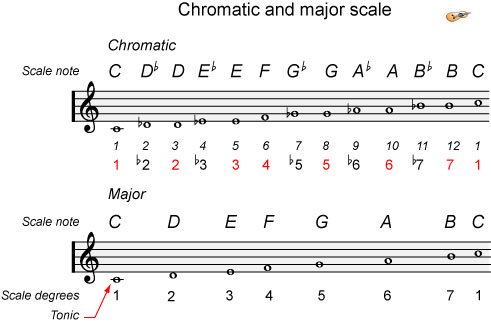
Using numbers instead of letters for notes can be much easier, the brain works better and quicker with
numbers, in particular the 1, 3, 5 notes are very important because they are the notes of a major chord.
The guitar fretboard is a complicated collection of notes and the 1, 3, 5 can be used as sign posts to
find the other notes.
For example, here are the 1, 3 and 5 notes of the C major chord. In this context the notes are called tones or chord tones.
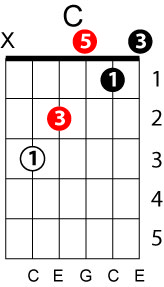
The interval between each chromatic note is a semi-tone. The major scale has a specific sequence of tones (t) and semi-tones
(s-t): |t| - |t| - |s-t| - |t| - |t| - |t|- |s-t|. This is the scale most used in popular songs. The distinction between
tone and semi-tone is somewhat artificial as everything can be expressed in terms of semi-tones however using tones and
semi-tones is the traditional way of defining a major scale. To make things more confusing some people use the terms step
and half-step.
Since a semi-tone is the distance between two notes one fret apart on the guitar it's appropriate to call it a fret-step (f-s).
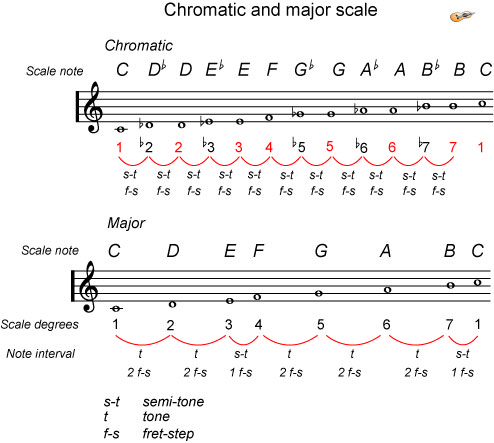
Major scale notes (melody)
The melody of a song is played using the notes of a particular scale most often the major scales such as in the image above.
The scales are:

There are 15 major scales, these are placed in order of falling fifths which we will talk about later.
Many guitarists have a preference for certain scales and this is because there
are more open chords (chords that have open strings) in this range of scales than the other scales.
Chord structure (harmony)
The harmony in songs comes from chords. The combination of notes resulting from using every 3rd note in
groups of three (i.e. C major = C-E-G) in a scale, and playing them together. If you have ever heard the
singing of a barber shop quartet or an acapella
group you know what I mean.
The first note or root of the chord has the
lowest frequency and it is the note that resonates the most. It's the tone that allows us to
identify the chord when we are listening to music.

A major chord also called a triad has only 3 different notes, on the guitar we are playing 4,
5 or 6 different strings for a given chord as opposed to the piano where we play only the 3 basic notes.
On the guitar some notes are repeated, the repeated notes are in a higher octave. Here are the chords
E major (6 notes), C major (5 notes) and D major (4 notes).
The E major chord is played with all 6 strings, there are two extra E notes from higher octaves and
one additional B note. In the case of C major we play one additional C note and an additional E note,
and in the case of the D major one additional D note. The X's indicate strings that are not played, and
the O's strings that are played open (i.e. not fretted). These are known as open chords vs. fretted chords which can be
played anywhere on the fretboard without changing their shape.
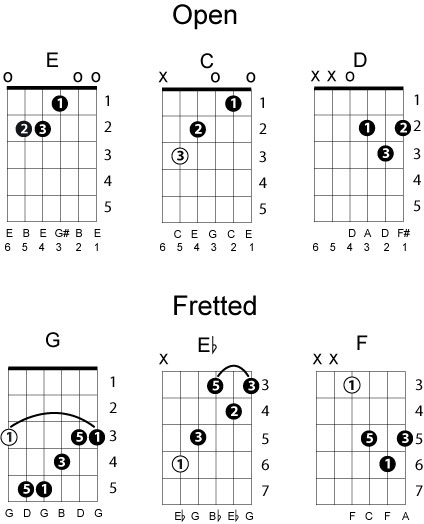
The notes on the guitar are arranged similarly to the piano with the difference that there is a different series of
notes on each string. You can start on the 6th string E and play the major scale up to the
next E one octave up on the 12th fret. Each open string starts on a different note.
Here are all the notes on the guitar up to the 15th fret:
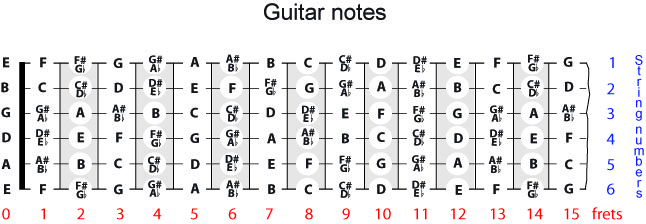
Scale degrees are not used for chords, the interval notation (1-♭2-2-♭3 etc.) called the chord intervals
is used instead since a chord's basic structure relies on intervals. Also chords are given roman
numerals to distinguish them from scale degree numbers in the sequence is I, ii, ii, IV, V,
vi, vii°, the lower capital Roman letter indicates a minor chord and the major chord is a capital.
The 7th chord is a called a diminished, it's like a minor chord on steroids and is accompanied
by a circle to indicate this difference.
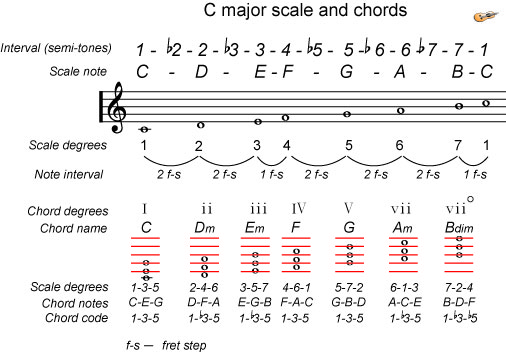
A chord code is the formula used to build a chord whether it is a major (1-3-5), a minor (1-♭3-5) or
a seventh (1-3-5-♭7). These numbers are easy to confuse at first with the scale degrees. The chord code
expresses the interval between the notes, the interval 1-♭3 is known as a minor 3rd and 1-5 as a perfect
5th. The important thing about a chord is the interval between the root note and the other notes, although
there are other intervals between the notes that are also important such as the tritone interval
contained within the diminished chord. The tritone interval is critical to promoting dissonance and tension which
we will talk about later.
The flats (♭) in the chord code do not correspond necessarily to flatted notes, they are a way of
expressing the interval between the notes of each chord.
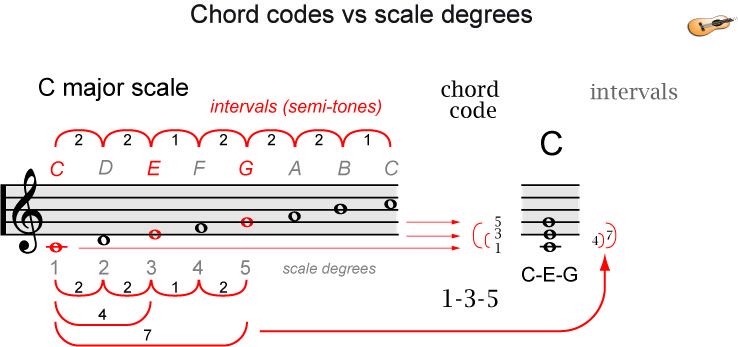
See the complete charts here.
Here are the names and abbreviations of the intervals:
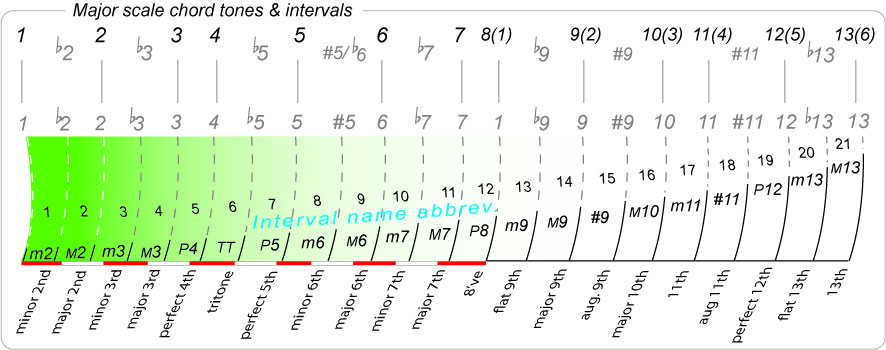
Chord quality is a way of expressing the variation of chords that exist, in an analogy to painting it's the palette of
colors. There are many chord qualities and here is a short list of them.
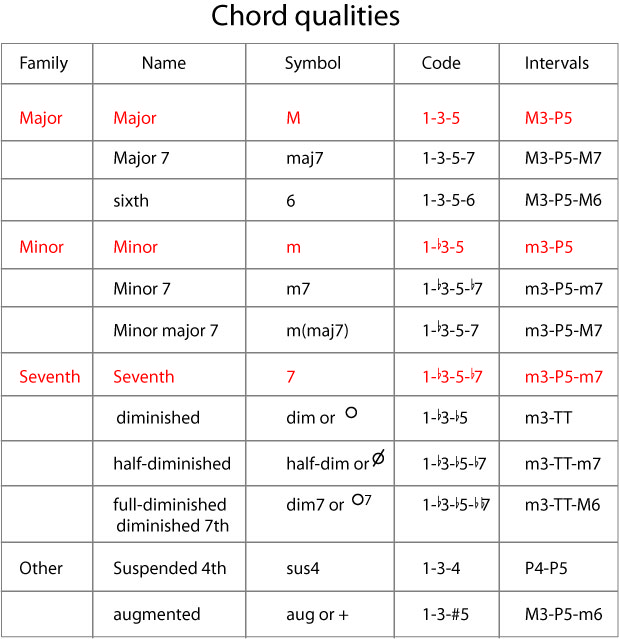
There is a longer more developed list a little further.
You can look up each one of the chords on the web and play them in your preferred scale to get a feel for their sound, or you
can figure them out for yourself with this chart. On the left you see the open form of this chord form, in this case C major represented
by the black dots. And on the right side the fretted form which can be played anywhere on the neck and will take the name of
the note of the fifth string that the root or tonic occupies. It looks like a jumble doesn't it? Concentrate on the tones that you need to
make the quality of chord that you are looking for.
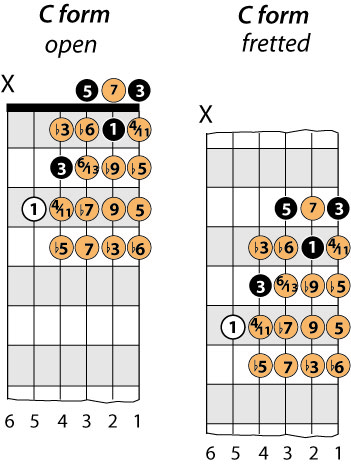
The positions for the tones of the chord are for the C form chords only, there are 4 other charts if you want to play those same chords
on a different part of the neck using a different form.
The complete chart for all the chord forms can be found here.
Chords are based on chord tones. You can memorize the shapes of all the different chords that you regularly play
such as: major, minor, 7th, maj7, minor 7th, etc. Or you can figure them out for yourself on the fly by knowing
the chord code and where the chord tones are for each chord form. By chord form I mean of course the 5 different
C-A-G-E-D forms.
Each chord form has a particular orientation (i.e. towards the body or the headstock) of the 1-3-5 chord tones
starting from the root note. Once you learn these all the other tones are easy to find.
Here are 5 often used chord forms and their tones:
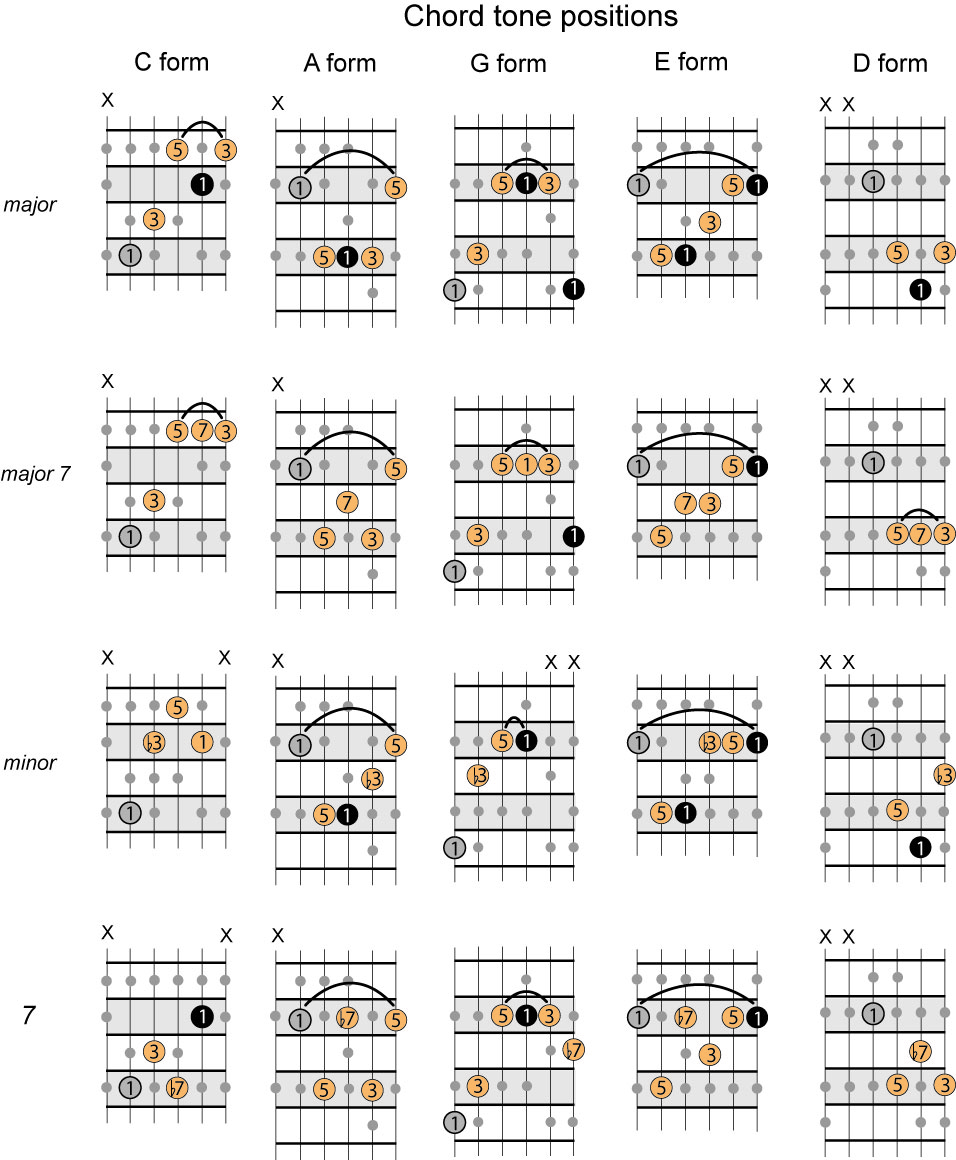
It sounds like allot of work to remember all of this. Don't worry it will come in time, the vocabulary or
jargon is necessary if you are going to appreciate the complexity of song structure. It's like wine tasting;
you can't talk about it if you don't have the vocabulary.
Chords have two major elements, intervals and function. Intervals are the basis of harmony and function is
how one chord relates to another and its function.
Minor, harmonic, melodic and pentatonic scales
Scales come in different types: major, minor, harmonic, melodic and pentatonic and they are used to
evoke different emotions. These different scales add variety. Allot of popular music is based on the major scale.
The natural minor scale is the same as the major scale but starts on the sixth chord. Starting on the sixth
chord means that the tonal center is now a minor chord, this means that the whole feeling of a piece will
be different, more sombre or moody.
Minor natural and harmonic scales

Here are some examples of popular songs played in the major and minor scales.
Major scale: Let it be - Beatles, You are the woman - Firefall, Feels like home to me -
Randy Newman/Bonnie Rait, Stardust - Hoagie Carmichael/Willie Nelson
Minor scale: Rockie Raccoon - Beatles, Walk on by - Burt Bacharach/Dionne Warwick, Losing my religion -
R.E.M., Still got the blues - Gary Moore
The songs can be found here in this sortable database from www.chordsandguitar.com.
The harmonic is a modification of the natural minor, the fifth chord of the natural is changed from a minor
to a major chord which brightens up the scale making it more similar to the major scale but keeping many
of its minor qualities. This is done by sharpening the 7th scale degree of the natural minor scale.
The melodic scale is a further alteration of the harmonic scale making it even more similar to the major
scale. This is done by sharpening the 6th scale degree of the harmonic scale.
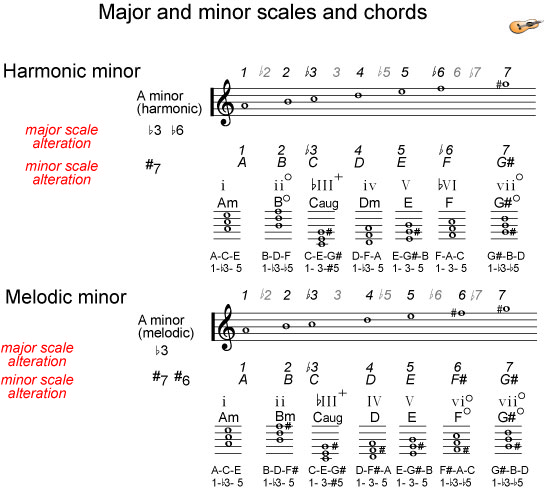
Chord forms (C A G E D) and scale positions
Every chord can be played in 5 different ways called forms. These forms are called C, A, G, E and D. They are
fundamental to the guitar and it's tuning. Typically when playing a song we use a mix of these forms because
this puts all the chords in the same region of the neck. For example say we play a 1 - 4 - 5 progression in the key of A which
is very typical and we could find in a thousand songs. Typically we would play this A (A form), D (D form)
and E (E form). However you could also play all three chords as A or D forms.
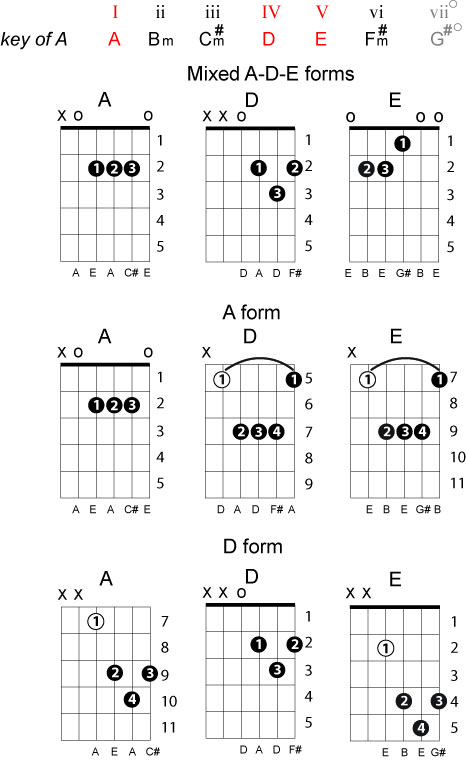
The forms are linked together on the fretboard.
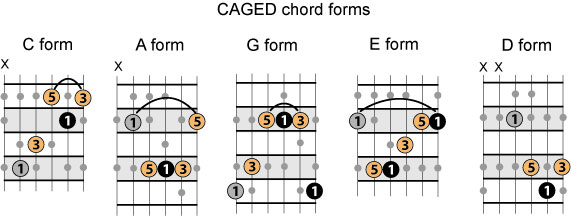
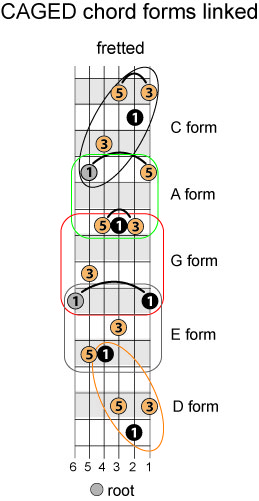
This can be very useful when you need to play the same chord on a different part of the neck. Every one of the chords
is a C major chord if the root of the C form is played near the head on the 5th string 3rd fret.
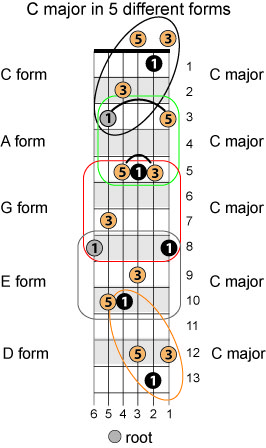
As we have seen previously chords are notes that are selected from a scale. Since there are 5 different chord forms
there are 5 different scales one for each chord form called a position.
Here are the C and A chord forms for the major scale.
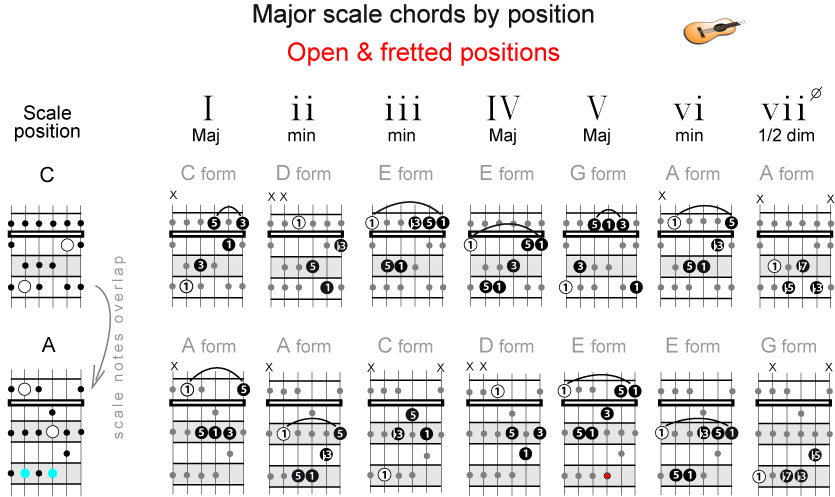
The complete chart can be found here.
Fretted positions refers to chord forms that can be played
anywhere on the neck.
Each chord form has a corresponding scale position. Position means the sequence of notes on the guitar that corresponds to the form.
For example, C form chord corresponds to C major scale.
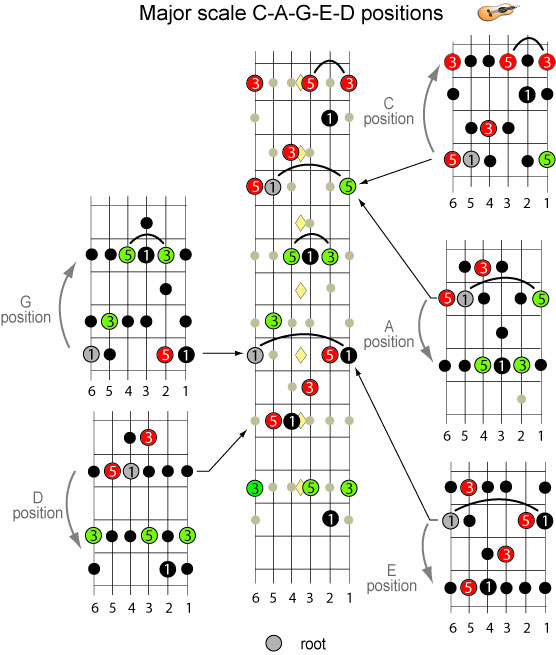
There is a characteristic direction of the scale position or chord form notes. The E and G forms have the root note on
the sixth string and are directed respectively towards the head and towards the body, the C and A forms are similarly
directed but the root starts on the 5th string and the D form is directed towards the body and starts on the 4th string.
The scale positions go hand in hand with the chord forms. Each note of a given chord for a specific form will take
its notes from the corresponding scale position. This will allow you to do the melody based on a scale position
corresponding to the chord.
Chord qualities, names and codes
In the major scale there is only 3 different types of chords, the major (1-3-5), the minor 1-♭3-5) and
the diminished (1-♭3-♭5). The minor and dimished are said to be chord qualities. The diminished chord
is not often played in songs and when it is, it is often replaced by the half-diminished (1-♭3-♭5-♭7).
When you play the other scales many other chord qualities turn up such as: the augmented (1-3-#5) in
the harmonic and melodic, the sixth (1-3-5-6) and the 6add9 (1-3-5-6-9) in the pentatonic,
minor 7 (1-♭3-5-♭7) in the major pentatonic and 7sus4 (1-3-5-♭7) in the minor pentatonic. Many
other chord qualities are used to suit the type of music being played jazz, pop, rock or other. Chords have emotional
content that comes from their respective intervals.
The rules are not complicated but a little tricky at first. This table groups them into families. This
table shows only the most commonly used chords.
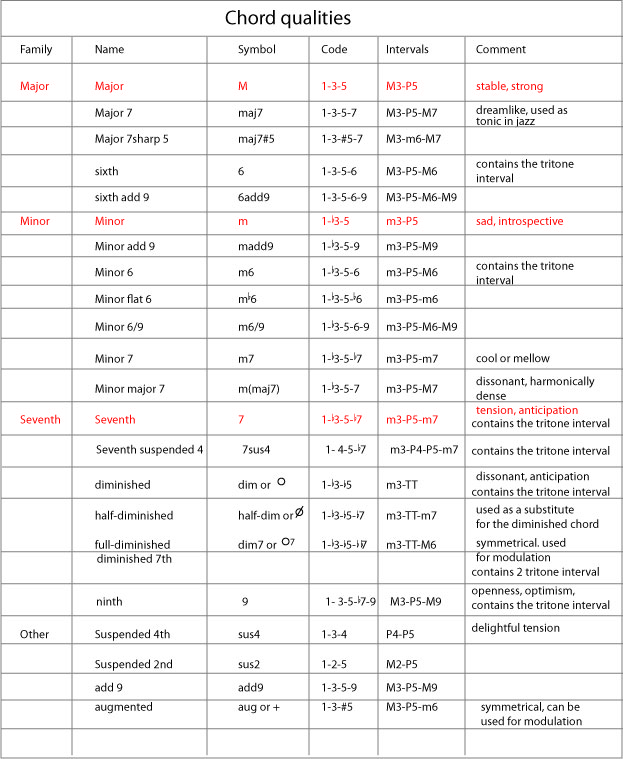
We can look at these intervals or chord codes in a linear layout like on a piano keyboard. The tritone interval
is in red to highlight its importance as we will see shortly when we look at chord function.
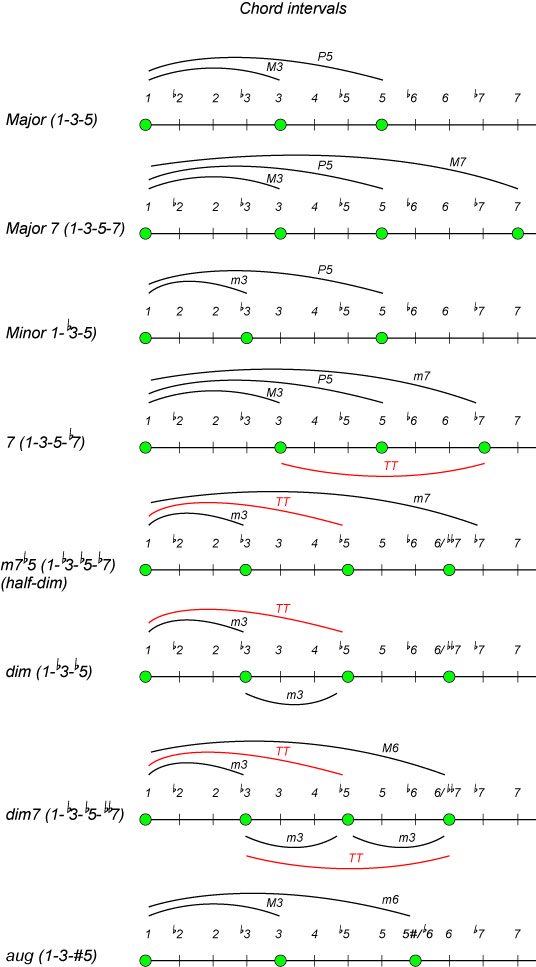
Let's take a look at the propertise of some chords that will help us to understand song structure.
Major and minor
A major chord is upbeat, positive; a minor chord is sad or sombre. They are the two most popular chords that
we hear in contemporary music. Learning to hear music and play it requires that you can tell a major chord
from a minor chord, it's not hard and you can get it after only a few tries.
Dominant
The name dominant does not refer to a chord but rather a function. It is the V chord of a major scale. It has
direction and tension, we have expectations that it will resolve to the tonic I.

In melody a 2 to 1 sequence of notes is a strong relationship, as well as a 7 to 1 (leading tone) and 4 to 3. The V chord has 2 of
those relationships the 2 to 1 and the 7 to 1 which strongly propels it to the I chord.

Dominant 7th
The dominant 7th chord or 7th is important because hidden inside is the tritone interval (TT). This interval
sounds unstable or un-resolved and for that reason this chord quality is often used in the fifth (V) chord
position to lead into the tonic (I) providing heightened tension and an expectation of resolution. You can hear this in the chorus of
Girl by The Beatles (see appendix). The progression is I-iii-vi-V7 and then I, or G - Bm - Am - D7. This
sequence V7-I is so often used it is given a name the cadence.
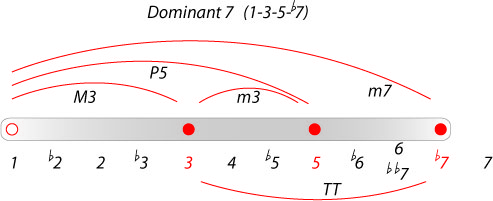
The dominant 7 is the V7 chord of a major scale. It has
direction and tension, it wants to resolve to the tonic I chord. The addition of the seventh creates a sense of tension and begs for resolution to the tonic. It's function is
to establish the tonality or tonal center with a V7-I cadence.
This is especially important when moving to a new key (modulating).
In melody a 2 to 1 sequence is a strong relationship, as well as a 7 to 1 and 4 to 3. The V7 to I
is powerful because it has all 3 relationships, the 3-punch knock-out combo.
The dominant 7 tension is caused by the tritone interval. The 2 notes that make this interval in the G7 chord are B and F. B wants to naturally go to the tonic C
only a fret-step away and F wants to go down to E making the C major chord C-E-G. This pull is so strong that it defines
the tonality or tonal centre of the song.

When you are at the end of a verse and are starting a new verse or going to the chorus this allows a reset or a feeling of going home.
It is also used to modulate (changing key) since the dominant sevenths are connected by a fifth which allows a smooth transition between keys.
More about modulation and falling fifths later.
These are the dominant 7th chord forms.
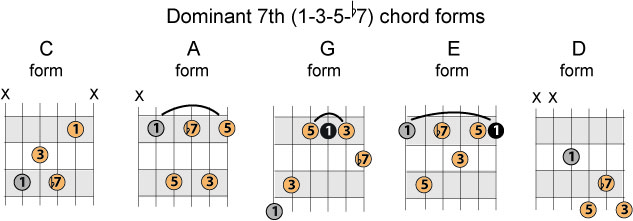
Diminished
The diminished chord is the 7th chord of the diatonic scale, it contains the leading tone. In the scale of C major that
is the note B. In a melody sequence B strongly wants to move up to C, or 7 to 1. It also contains the tritone (TT) interval
which is strongly dissonant.
The diminished chord is contained within the dominant 7th, the dominant 7th of all chords has the strongest tendency to resolve to the tonic,
the diminished chord has the same tendency.

In melody a 2 to 1 sequence is a strong relationship, as well as a 7 to 1 and 4 to 3. The diminished
chord also has those 3 relationships but it lacks the stabilizing 4th note that G7 has which makes it
much more dissonant.

These are the diminished chord forms:
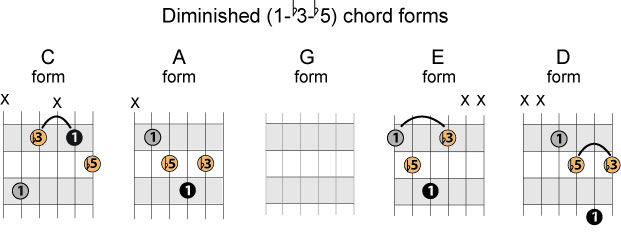
Half-diminished 7th
The half-diminished chord also has 1 tritone (TT) interval.

The half-diminished 7th chord can be used as a substitute for the diminished chord which appears naturally in a major scale.
It has a brighter less eerie sound to it without sacrificing the function of the leading tone 7th resolution to the tonic.

These are the half-diminished chord forms.
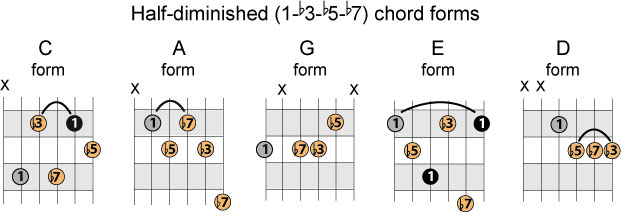
The diminished 7th
The diminished chord is remarkable in any ways. It is unstable and leads to another chord.
If you drop the root tone tone down by a semi-tone you create a dominant seventh chord, creating a great opportunity for modulation. For example,
when the root of G#dim7 - 1-b3-b5-bb7 is dropped by a semi-tone it becomes G7 - 1-3-5-b7.
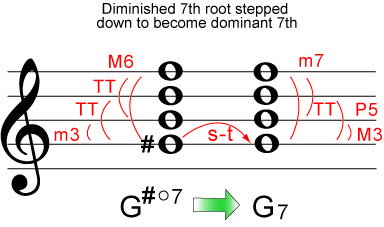
It can serve as a passing chord, a harmonic filler between 2 chords. For example, C, C#dim7, Dm7, G, is the 1-2-5
progression with the dim7 chord slipped in between 1 and 2. Why does it work as a passing chord? For one it creates
a nice ascending bass line G-G#-A and it is unstable because it contains the tritone interval which provokes a
resolution to a chord a semi-tone upwards to a major or minor chord.
It can also be used as a substitution for a dominant 7 chord which we will talk about later.
The diminished chord has interesting properties, it can be seen as a stack of minor 3rds (see previous diagram on intervals) or 2 tritone
intervals. It is unstable and therefore pulls you toward another chord usually a major but could be a minor.

The diminished seventh chord is symmetrical because the interval between each note is a minor 3rd, and there are 4 equally spaced minor 3rd
intervals in an octave. It is tonally ambiguous and any note of the chord can be used as the root. There are 2 tritone intervals in
the diminished 7th which is the source of its instability.
If you re-write the notes of Ebdim7 such that Bbb is A and Dbb is C you will see that Cdim7 is the same as Gb dim7, Adim7, and
Eb dim7 creating opportunities for modulation.
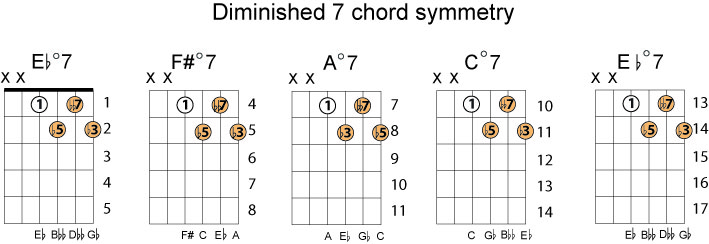

In a leading tone seventh, every note typically resolves by step to the major or minor triad whose root is a diatonic fret-step (f-s) above the root of the seventh.
A viidim7 on B, for instance can resolve to either a C major or a C minor triad.

The diminished 7th is also used frequently in modulation - the ambiguity of its symmetry allow for multiple possible resolutions,
which make it a very versatile tool for harmony.

The augmented chord
The augmented chord is unstable and leads to another chord. It is a major chord with a sharpened 5th. The augmented chord
is often used in popular songs. It can be used to promote a line - a sequence of notes that is not the bass line or part
of the melody. Stevie Wonder's "For once in my life" is a good example of this. It is tonally ambiguous; any note of the
chord can be used as the root.
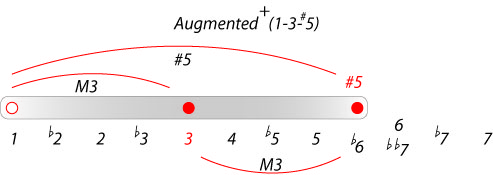
The augmented chord is also symmetrical and all its notes repeat every 4th fret, this is because all the
notes are separated by an interval of a major 3rd. The diminished 7 and augmented chords are the only chords
that are symmetrical.
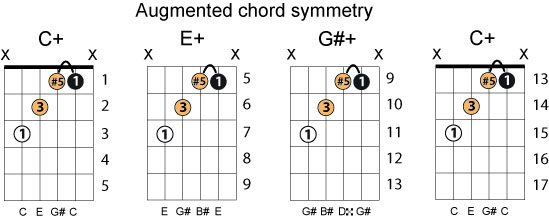
The augmented chord as with the dominant 7th leads into the tonic. One example is the first chord of "Oh Darling" by The Beatles
and Eddie Money's "Baby Hold on to Me".
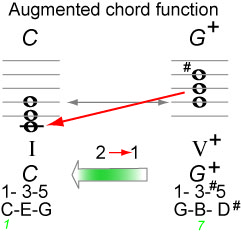
These are the augmented chord forms.
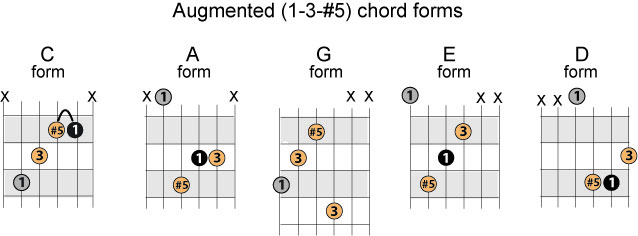
The sixth or major 6
The sixth chord is a major triad with an added sixth, 1-3-5-6.

The sixth chord is often used in popular songs. Depending on the context it can be viewed as an inversion of a
minor chord. An inversion is a chord whose notes are out of the normal sequence where the tonic is replaced by
one of the other notes. For example Am is often played with the tonic A replaced by C. This is often used to
promote a bass line in that case the chord will be identified as an Am/C which is really its function.
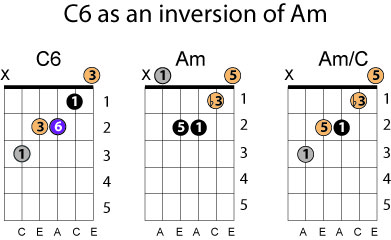
How a chord functions in a song depends on the context, or the function it has with respect to other chords
and the tonal center.
Notice that the C6 in this form does not have a 5 tone. This is not unusual as often the 5 tone will be
omitted without detriment from some chords in a particular form to facilitate the fingering on the guitar.
Here are all the forms of the C6 chord, only the C form omits the 5th tone by necessity.
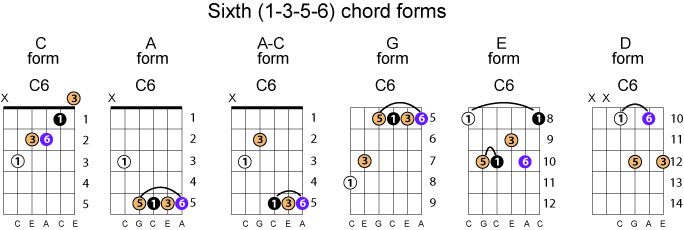
Other seventh chords
All of the other 7th chords are mainly used as color, in order to "spice up" the sounds of simple
triadic harmony. Color is subjective, here are the most common ideas associated with each one.
Major 7th - Sometimes described as "dreamlike". Often used with the tonic in jazz music.
Minor 7th - Described as "cool" or "mellow" by some. It is often used in the ii chord, as a pre-dominant (substitute for IV).
Half-diminished seventh - The 7th in this case sort of takes the edge off of the diminished quality of the chord.
It is often used as a vii° chord in first inversion as a pre-dominant chord.
Minor/Major 7th - this is the most harmonically dense of the 7th chords, it is very dissonant. It's upper 3 notes form an augmented triad,
and it has a major 7th span. However, when voiced properly it can actually sound quite beautiful. It doesn't have a standard diatonic use.
Chord function
Before we get into song structure let's take a look at chord function. What is it? Understanding the function of a chord means solving the
problem of what chord follows next.
In the scale of C C major is the tonic and G, the fifth chord of the scale, is the dominant. These terms tonic and dominant describe
the function of the chords, tonic is the home chord or the place of rest if we look at it from an emotional standpoint and G or
G7 is the dominant which creates tension and likes to move, some say resolves, to the tonic. Try it on your instrument, you'll see
there is a force driving the dominant to the tonic.
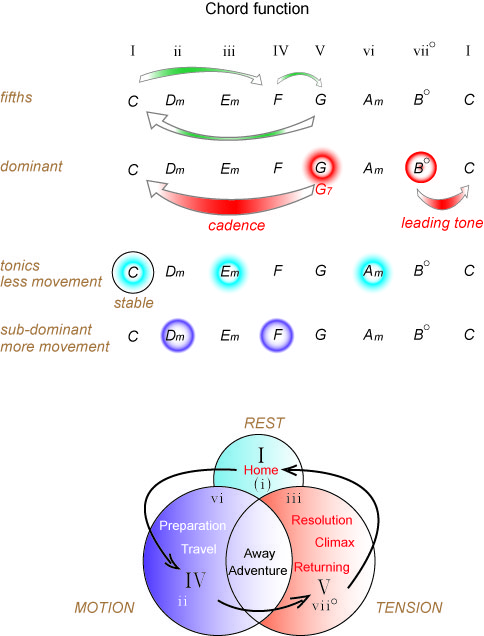
Song structure
So what are songs about? Essentially they all contain some elements of rest, motion and tension.
You have all the chords you need in a major scale to generate these sensations. There is of course many
more tools to use, all the different chord qualities are available to fine tune and make the experience
different. For example instead of using a straight minor chord, you might have a minor 7 or a minor major 7,
a major chord could be turned into a sixth, the diminished chord is most often played as a half-diminished
a more harmonic version. All such variations are used constantly but there is one thing that brings
everything back to a common point, the tonal center.
The tonal center is the HOME of the song. If the song uses chords all in the same scale (diatonic) then
it is the I chord of the scale that is HOME the most stable chord of the scale. The I chord is also called
the tonic. In that case the tonic is also the key of the song. Finding the key of a song is not always
obvious, sometimes the verse will start in the key or finish in the key and sometimes not. You have to
look for the tone that is most restful.
Songs that change key or modulate provide more diversity and opportunities to surprise the listener.
That's where the tonal center comes in because at some point the song writer will bring you back to
that center (home).
The song "Stumblin' in" in by Suzie Quatro is a great example of a diatonic song. At the other end
of complexity is "How about you" interpreted by Harry Nillson using marvellous intricate modulation,
chord substitution, different chord qualities and chromatic chords. "Stardust" is somewhere in
between, interpreted by Willie Nelson. You can see the structure analysis of these in the appendix.
Stumblin' in
How about you
Stardust
The falling fifths or circle of fifths relationship
Falling fifths is a sequence of major scales organized a perfect fifth apart. It is often talked about as the circle of fifths.
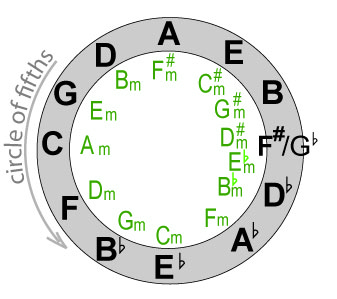
In the outer circle is the tonic of a scale (major chord) and in the inner circle the tonic of the corresponding
minor scale (for example C and Am). Separating the scales by a fifth provides a more appropriate way of structuring
the scale to analyze song structure. This is a relationship between scales or keys.
The same sort of relationship exists between chords within a scale. To experience this play a major scale in the
order of fifths such as C major.

The falling fifths sequence produces naturally a pleasant melody. This is because the root of each chord is separated
by a perfect 5th.
Here are the major scales and the corresponding minor scale of each scale organized in falling fifths.
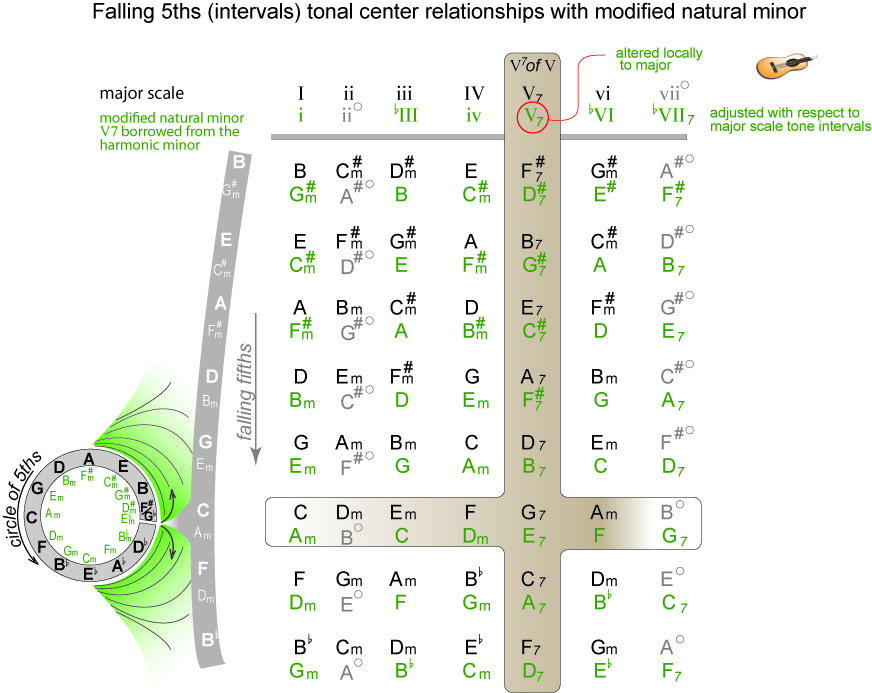
The circle of fifths is unwrapped so we can see every chord of each scale. Since C is a very popular
scale it is chosen as the center of the chart, the complete chart is in the
appendix.
Most songs do not stray too far from the tonal center. They probably will not modulate further than
2 scales above or 2 below from the tonal center. So that if C was the tonal center, no further than
D or Bb. This is because it is difficult to modulate further than that without jarring the listener.
Fortunately there are many tricks to help you accomplish these far modulations. Here are 2 songs
that have a close modulation and one with a very wide modulation range.
This song by Martha Reeves and the Vandellas is using only chords in the key of C in the verse. In
the bridge she attempts to change key by going from G to D7. This is the classic way of changing
key by going to the corresponding fifth of the scale you want to go to. You can see now why putting
scales in the falling fifths order is so helpful. The D7 is called the five 7 of five (V7 of V).
This is a perfect opportunity to change key, we would then go to G (cadence) and then start fresh
on the G key. But no in this case she goes back to the G of the tonal center (C) to repeat the verse.
They don't always do what you expect them to do.
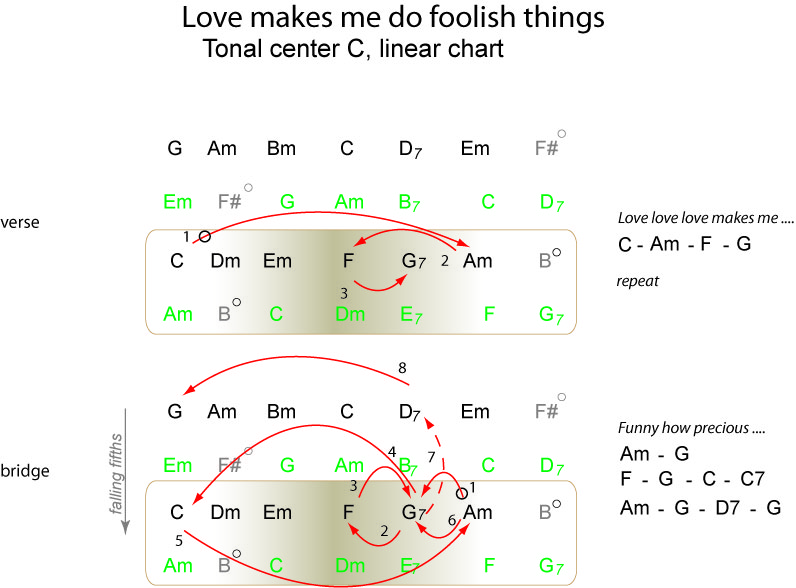
Substitutions
Diatonic Chord Substitutions
Dominant Chords Alternative : Diminished
Interpolation and Back Cycling
Jazz musicians play the ii-V cadence most of the time when resolving to the I chord. Therefore, the V-I can become ii-V-I. It is know as
interpolation. In this example, I put the ii in front of the V:
The Neoplolitan 6 (N6)
The Neapolitan 6 is a pre-dominant chord so that it pulls to the V chord of a scale. It is constructed by majoring and flattening
a ii chord making it a bII.
It substitutes for IV and ii chords in a major key and iv and VI in a minor key. One example of its use is at the end of the
bridge in The Beatles "You're going to lose that girl".
The tritone substitution
The tritone substitution is a chord that can substitute for the V7 of a key thereby surprising the listener, offering more
variety and delaying an expected resolution. Much of our life with a partner has that kind of theme, don't you think?
The chord that acts as a substitute is the bII7. If you are in the key of C, the V7 of C is G7 and bII7 is Db7.
The reason Db7 can substitute for G7 is they both have the same tritone interval and since this interval is the most
powerful part of the chord they can substitute for one another.
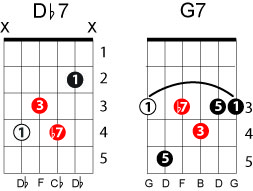
They both want to resolve to the tonic C. In the case of G7's move to C
all the strong melody note relationships (7 to 1, 4 to 3 and 2 to 1) are enlisted. For the Db7 move to C only the 7 to 1 and 4 to 3 relationships
are used making that movement slightly less strong than G7 to C.
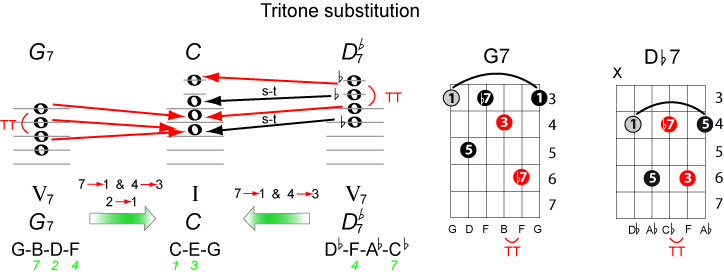
Instead of playing this progression C Dm7 G7 C which is a I ii V7 I, a typical
diatonic progression, we can play C Dm7 Db7 C or I ii bII I.
An alternate way of using the tritone substitution is to place the dominant note in the bass. Doing this creates some
delicious dissonances: C Dm7 Db7/G C; the Db7/G is a little bit tricky and can be played in this fashion:
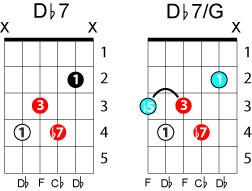 creating another tritone interval colored in blue.
creating another tritone interval colored in blue.
We can use the tritone substituion to change key or modulate form C to Eb for example: C Db7 Bb7/D Eb, Bb7 is the the V7 of Eb.
Bb7/D is another tricky chord to play, the Bb7 can be played this way in a G form:
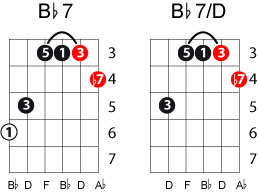 this progression features a chromatically rising bass line.
this progression features a chromatically rising bass line.
The Neapolitan 6 is a special case of the tritone substitution. The Neapolitan chord takes the flat-II (Db-F-Ab) and
places the F in the bass, and it takes the place of an F chord that moves to G. So it turns this: C F G C
into this: C Db/F G C. Theres' no tritone substitution in this case but it's the same idea.
The Db/F can be played like this:
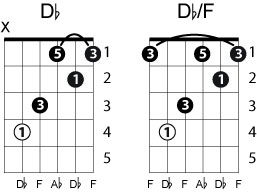 this progression features a chromatically rising bass line.
this progression features a chromatically rising bass line.
The tritone substitution can occur in any scale or key since it is always the bII of the V7, here's a list for all subs for each scale:

Changing the Color
Any chord can be played using another color. It works particularly well on chords than have already been substituted.
For instance, if you play Db7 instead of G7
Try Db major 7th, or Db diminished 7th, Db major 6th.
Modulation
Modulation is changing key within a song, trying to establish another tonal center usually temporarily. It adds variety, surprise and
brings the thread of the story to unknown places. There are several ways to do this without losing or confusing the listener, some are abrupt and
others are intricate similar in complexity to going on the first date.
Modulation helps us understand how songs are structured. Songs are not just a haphazard collection of nice sounding chords;
the chords are well chosen to make a statement while complementing the melody. How are they chosen? That's complicated
and depends on the writer's inspiration, her process may be inaccessible to us but we see the result. The result is that
each chord plays its role or function. The function of the chord tells us where it is likely to lead or what
brought us to it. This can be seen in action by looking at a linear or circular harmonization chart, many examples are
in Appendix XX. This is what lies behind the curtain. A useful by-product of understanding the modulation techniques
and chord function is that it will help you verify what you are hearing and come up with an accurate chord
progression for any given song.
Relative minor
The relative minor of a scale is its sad twin brother. C major's relative minor is A minor, it is the vi chord of C major scale that now becomes the tonal center.
This new center or tonic is now a minor which gives the scale it's heavy sad feeling. The natural A minor scale is identical in
sequence to the C major scale except that it starts on Am.

The natural minor scale suffers a little from a lack of assertion because it lacks the dominant 7 in the fifth position, so the modified scale provides this
feature by trurning the v minor chord into a major V which makes it possible to get a V7-I cadence and establish the minor key as a strong tonal center.
Pivot or near key
Common chords are chords that are common to two different scales usually closely related. For example C, Em, G and Am are common
to both C and G major scales. The pivot chord is the chord we will use to modulate from one scale to the other.
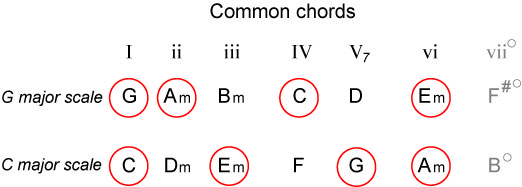
Altered common chord
Suppose you want to modulate to a distant key, but don't want the abrupt sound of direct modulation,
altered common chord modulation is a great solution, say from the key of C major to the key of F minor.

If we alter F in the key of C major to Fm, then we can use Fm as a pivot chord.
Sequential
Paralell
A song establishes tonality in a major key such as C major then moves to the parallel key C minor or vice versa.